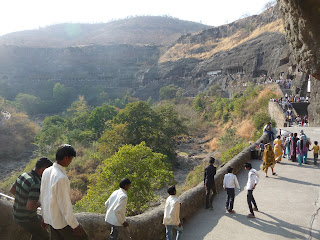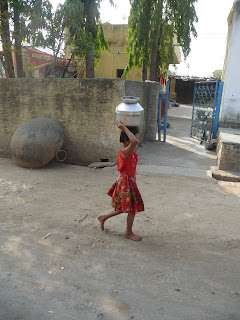Elizabeth Krawczun, Verrazano Class of 2014, has returned from her winter study abroad experience in Jamkhed, India. Read below for her perspective on the experience. More detailed explanations of the photographs are available at the end of the post.
My study abroad in India was an opportunity that I will
not forget. I met some wonderful people who have donated their lives to the
hospital and its work. I made some good friends, both fellow students and staff
in the facility, who are driven and determined to help others. I saw the
poverty of some villagers and mistreatment of women. Further, I came to realize
that I do want to pursue public health. Before travelling to India, I had some
reservations about what I had chosen as my intended major and future career
path. While abroad, it became clear to me that public health is where I would
like my work to be directed.
I am going to miss many of the people I spent the last
three weeks getting to know. Becoming a part of the “CRHP family," as they say,
was an emotional experience on its own. Despite the short amount of time there,
I became attached to the people through their stories. Every woman trained by
CRHP as a health worker in her village had a story. Having the opportunity to
see these women fight against their oppression and become empowered was
beautiful.
It was difficult to not be affected by the level of
poverty and gender inequality when walking through the villages and cities. As
Westerners, we were all struck by how differently people live and we all felt a
little ashamed of how well we live and how secure we feel in the United States.
The purpose of this study abroad was to do exactly that;
to force us to realize that these people have next to no way of changing their
situation. CRHP’s goal is to provide the people with resources to solve some of
the most basic problems - to shift the focus of biomedicine from curative to
preventative. When walking through the villages, I was able to see how the
villagers had implemented some of the changes and how bringing resources and
health care capability to the people was the best solution to combat the
growing rate of disease.
This study abroad had its own difficulties, one of which
was communicating with non-CRHP administrators. This was sometimes a
struggle. I was able to pick up some words in Marahti, but never really learned
enough to do more than ask for tea. Secondly, it was very tough being an
American there. Three of my fellow students were of Indian descent. I drew the
most attention because I was tall in an area where the average height is 5’2”
and have a very light complexion. In the cities, and when we travelled to two
religious sites, people would circle us and take pictures, silently take
videos, and corner us, laughing, and snapping pictures. Many times, people
would come up and ask if we would take a picture with them. Again, I was
singled out for being the fairest and the tallest. It was very uncomfortable,
and some of the rest of the group and I never quite felt safe outside of the
hospital grounds.

 This study abroad was an experience that I will never
forget. It is not meant for students who want to have a good time or learn the
history and go site-seeing. We studied and discussed the village trips more than
reading from a textbook or having formal classes. This program is for students
who do not mind living in sparse conditions with few amenities outside of the
necessities. When people now ask me, “How was India? Did you have fun?” I
don’t quite know what to say. I had an interesting educational and emotional
journey, but I cannot call most of my time there “fun." I did have fun with
students and interns at CRHP, but the actual course was down and dirty. The professor
I travelled with and the directors of the hospital wanted us to see village
life for what it really was. I would go back to study and contribute to the
hospital in any way I can. I am grateful for this study abroad experience and
appreciate the opportunity to share in such a wonderful cause.
This study abroad was an experience that I will never
forget. It is not meant for students who want to have a good time or learn the
history and go site-seeing. We studied and discussed the village trips more than
reading from a textbook or having formal classes. This program is for students
who do not mind living in sparse conditions with few amenities outside of the
necessities. When people now ask me, “How was India? Did you have fun?” I
don’t quite know what to say. I had an interesting educational and emotional
journey, but I cannot call most of my time there “fun." I did have fun with
students and interns at CRHP, but the actual course was down and dirty. The professor
I travelled with and the directors of the hospital wanted us to see village
life for what it really was. I would go back to study and contribute to the
hospital in any way I can. I am grateful for this study abroad experience and
appreciate the opportunity to share in such a wonderful cause.
Photo Descriptions
The first picture shows one of the times that the
group was greeted into the home of one of the village health workers.
Generally, special guests are greeted with the placing of red and yellow paint
on the forehead, the giving of sweets, the kissing and painting of the feet
and, and the burning of incense. This particular woman also gave each of us a
coconut, which is considered a good omen.
The second picture is of a girl carrying a pot of water
from the water truck to her home. This part of India, on the Deccan Plateau, is
experiencing a severe drought and has had no rainfall for over a year. Because
there was next to no crop yield, no drinking and bathing water, and less
sanitation in the villages, disease and dehydration are major problems. Thirty
years ago, CRHP built tube wells in poorer areas that would collect and store
the ground water. Now, these tube wells are dry and the government is now
intervening and sending water trucks to the villages. One of the main concerns,
however, is that some villages have water trucks come every day, while others only
get water once a week. Because India is very corrupt, areas where the mayor
knows one of the government officials are able to pay off the official and have
access to more water.
The third picture is of me at Sancrant, the women’s
festival. At this point, the group and I had left the first mosque and were
about to travel to a temple to continue the celebration. During this festival,
women bless each other with the red and yellow paint, sesame seeds, and sweets.
The fourth picture was taken during a trip to the Buddhist
caves of Ajanta, located in the Aurangabad district. The entrances to the caves
are all along the edge of this cliff-like area. It is believed that these caves
were built between the second and seventh century. The sculpture within these
caves was amazing, as were the paintings and murals on the walls. These caves
were discovered in the early nineteenth century.
The last picture shows a village health worker
demonstrating how she takes the blood pressure of the villagers. The equipment
that these workers have is out-of-date and the hospital is trying to provide
more advanced basic equipment with donor contributions.



NICE BLOG!!! I'm happy to find numerous useful info here in the post. I would really like to come back again right here for likewise good articles or blog posts. Thanks for sharing !!
ReplyDeletesv university distance education
Thanks you for your best information!
ReplyDelete| Distance Education